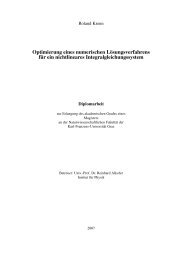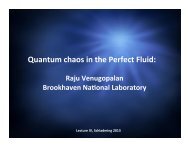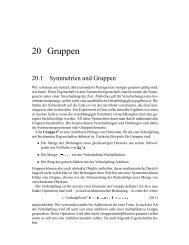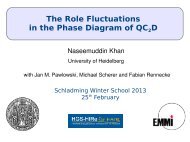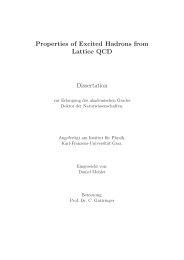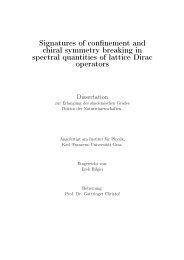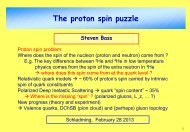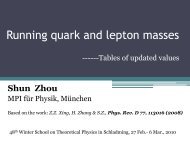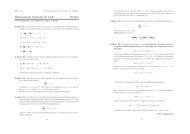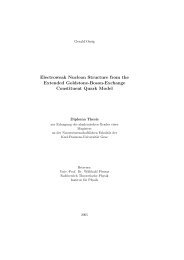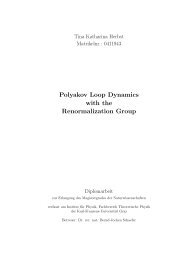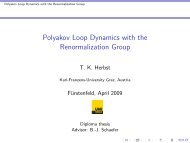The QCD Quark Propagator in Coulomb Gauge and - Institut für Physik
The QCD Quark Propagator in Coulomb Gauge and - Institut für Physik
The QCD Quark Propagator in Coulomb Gauge and - Institut für Physik
You also want an ePaper? Increase the reach of your titles
YUMPU automatically turns print PDFs into web optimized ePapers that Google loves.
92<br />
before we employ L<strong>and</strong>au gauge for these exam<strong>in</strong>ations.<br />
We solved the covariant Faddeev equations numerically to obta<strong>in</strong> masses <strong>and</strong> amplitudes<br />
for the nucleon <strong>and</strong> ∆. Scalar <strong>and</strong> axial-vector diquark masses were fixed by fitt<strong>in</strong>g<br />
stipulated masses of the baryons. We <strong>in</strong>terpreted the masses <strong>and</strong> Faddeev amplitudes thus<br />
obta<strong>in</strong>ed as represent<strong>in</strong>g properties of the baryons’ “quark core”.<br />
We expla<strong>in</strong>ed subsequently the formulation of a nucleon-photon vertex, which ensures<br />
the vector Ward-Takahashi identity is fulfilled. <strong>The</strong> vertex ansatz <strong>in</strong>volves three parameters.<br />
Two of these specify electromagnetic properties of axial-vector diquarks <strong>and</strong> a third<br />
measures the strength of electromagnetically <strong>in</strong>duced axial-vector- ↔ scalar-diquark transitions.<br />
<strong>The</strong>se quantities are also properties of the nucleons’ quark core.<br />
We explored a reasonable range of these parameter values <strong>and</strong> found that an accurate<br />
description of the nucleons’ static properties was not possible. This mismatch with experiment<br />
was greatly reduced by the <strong>in</strong>clusion of chiral corrections. <strong>The</strong> calculated behaviour<br />
of the proton’s form factors G p E (Q2 )/G p M (Q2 ) for Q 2 2 GeV 2 agrees with that <strong>in</strong>ferred<br />
from contemporary polarisation transfer data. Moreover, with the same <strong>in</strong>sensitivity to<br />
parameters, the ratio was seen to give √ Q 2 F 2 (Q 2 )/F 1 (Q 2 ) ≈ constant on Q 2 ∈ [2, 6] GeV 2 .<br />
S<strong>in</strong>ce the parameters <strong>in</strong> the nucleon-photon vertex do not <strong>in</strong>fluence these outcomes, we<br />
judge they are manifestations of features <strong>in</strong>tr<strong>in</strong>sic to the nucleon’s Faddeev amplitude. In<br />
the nucleon’s rest frame, this amplitude corresponds to a relativistic wave function with<br />
s-, p- <strong>and</strong> even d-wave quark orbital angular momentum components.<br />
In our view baryons can realistically be seen as a dom<strong>in</strong>ant Po<strong>in</strong>caré covariant quark<br />
core, augmented by pseudoscalar meson cloud contributions that, e.g., make a noticeable<br />
contribution to form factors for Q 2 2 GeV 2 . Meson compositeness ensures that such contributions<br />
dim<strong>in</strong>ish with <strong>in</strong>creas<strong>in</strong>g Q 2 . Hence future experiments at larger Q 2 will serve<br />
as an <strong>in</strong>structive probe of correlations <strong>in</strong> baryon wave functions, i.e. their Faddeev amplitudes.<br />
Comb<strong>in</strong>ed with further knowledge about <strong>QCD</strong>’s quark propagator, the structure<br />
of the 2-quark correlations <strong>and</strong> a more sophisticated treatment of chiral corrections this is<br />
likely to make clear if quarks <strong>and</strong> diquarks are suitable degrees of freedom for describ<strong>in</strong>g<br />
the nucleon.



